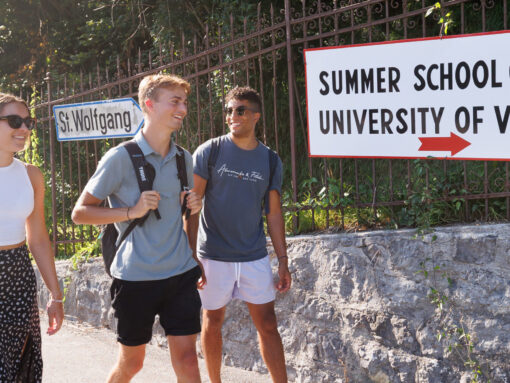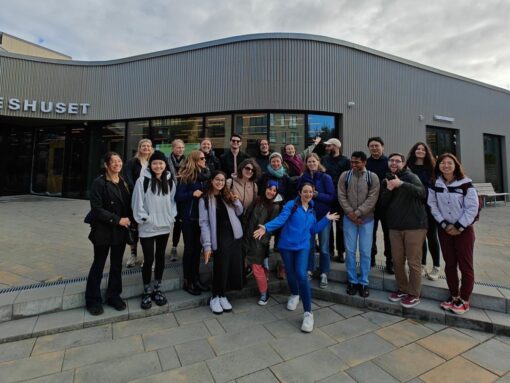In the early morning of October 14, 2023, 13 biology students from both Bachelor’s and Master’s programs, together with Univ.-Prof. Martin Zuschin, Dr. Jürgen Herler and Angelina Ivkić, MSc from the University of Vienna, set off for Marsa Alam, Egypt. Their destination: the reef of Mangrove Bay.

Reefs in Mangrove Bay
In this course, the primary goal was to document the diversity and abundance of fish, clams, and coral species in the reefs of Mangrove Bay. The reef was divided into different depth zones: the reef crest (0 m), the reef edge (3 – 5 m), and the reef slope (8 – 10 m). Equally important for the communities of species is their exposure to waves and currents. A distinctive feature of the reefs in Mangrove Bay is that one side is within a sheltered bay, while the other faces the open sea and is thus exposed to the influences of ocean currents.
Applied Methodology
To gather data, a method known as “line transect” was employed. A 20 m long tape was laid out parallel to the reef crest, reef edge, and reef slope. Along this line, clams, snails, corals, and fish species were carefully documented, photographed, and counted. To explore the differences between areas heavily influenced by currents and the sheltered zones, we collected data on both sides of the reef at the same depths. This systematic approach allows us not only to understand the absolute number of species but also their distribution in different habitats.
The students not only had the challenging task of collecting data on-site but also had to analyze it in Vienna. Each group was assigned an individual topic for which they had to write a report based on a literature review and the analysis of their own collected data.
The backbone of a reef: the corals
Coral reefs are formed through the symbiosis of animals, the corals, and photosynthetically active algae, also known as zooxanthellae. However, essential for the formation of coral reefs are enough sunlight and warm water temperatures. Increased water temperatures can lead to coral bleaching resulting from the breakdown of the symbiotic relationship between corals and zooxanthellae. Unfortunately, not only the Red Sea, hosting approximately 250 coral species, but coral reefs worldwide are no longer safe from bleaching events. For most students, including me, Theres, seeing bleached corals “in the field” was a first-time experience. Even though we thought we knew a lot about corals and had seen countless images, the reality was shocking. Even in a seemingly “healthy” reef, some corals are in such poor condition that they no longer sustain their vital symbiotic partners.
In addition to coral bleaching, the coral group focused on comparing the species composition in exposed and protected areas along the depth profile. Our observations have documented that the species composition of corals varies significantly in both areas. Branching corals like the genera Acropora or Pocillopora are more prevalent in exposed areas, whereas massive-growing corals like Porites dominate protected areas.
In regions of the reef with a lot of sunlight, the genus Stylophora is particularly abundant.
Another unique feature of Mangrove Bay: one cannot just explore recent but also fossil coral reefs. The coral group compared the diversity and species composition of the recent reef and the fossil reef, dating back 125,000 years.
It turns out that the fossil reefs were mostly dominated by the species Galaxea. Nowadays, this species is only rarely seen in recent reefs in Mangrove Bay. In general, less than a quarter of the species present today were also present in the fossil reef.
Clams and snails (Molluscs) of Mangrove Bay
The mollusc group has studied the coral and mollusc communities at the reef edge and researched differences between the exposed and the sheltered side. As we worked in shallow water we had to collect our data by snorkeling, which was very exhausting especially on the exposed side. The organisms were noted on waterproof paper with the help of a writing board. We found some interesting snails (gastropods) and clams (bivalves), of which I would like to present you the most exciting ones:
Tridacna, the giant clam, lives like corals in symbiosis with zooxanthellae. The algae provide the mantle tissue of the clam its beautiful color and protect them from UV radiation. Further they supply important nutrients, 70% percent of the requirement is covered in this way. They get carbon dioxide and phosphate from the clam in exchange. Similar to corals Tridacna can also lose its zooxanthellae and therefore bleach.
Dendropoma, the worm snail, has probably one of the most exciting ecological lifestyles among the snails. They live firmly attached between branching corals and stretch a mucus net resembling a spider net, which they use to catch plankton. The net is then retracted and digested together with the nutrient-rich content.
We found several cone snails on the sandy bottom in the lagoon. It is important to handle them carefully and not touch the aperture as they have a poison arrow and may use it on contact. Our interest in molluscs has been reinforced during the stay, additionally we learned a lot about corals. Several interesting animals and lifestyles can be found amongst the molluscs.
Reef fish: Vibrant colors, diverse functions
The fish group focused on the reef fish of the Mangrove Bay house reef. Thanks to the preparatory seminar we attended in the summer semester, a prerequisite for this excursion, we were able to engage in practical learning on-site, having acquired a solid foundation of knowledge on the selected topics. Before our dives, we prepared on land for the diverse fish life using identification books and presentations.
Additionally, we benefited from the results of a marine biology research group from the University of Tübingen. In our initial dives, we observed life around the coral reefs and consequently compiled a list of the 50 most common species. Fish from the families of butterflyfish, parrotfish, damselfish, and angelfish were particularly abundant.
In addition to counting fish, we observed the behavior of reef fish and drew conclusions about their roles in the reef ecosystem:
Butterflyfish are usually found in pairs. Small damselfish live faithfully in and around branched corals, retreating when potential predators approach. Parrotfish bite off coral pieces with their strong, beak-like mouths and excrete them as sand.
The diet of reef fish can be very diverse, with so-called food specialists and generalists. Some species feed exclusively on corals or smaller fish, while others also consume plankton.
Our task was to count reef fish in a selected area. We carefully delineated the area with measuring tape and strings, noted the sighted fish underwater on our list, and entered the data into our database after each dive. All the data we collected were compiled into a scientific report, allowing future students/researchers in marine biology to access and compare it with future counts if necessary. Despite physically demanding activities, we had a lot of fun and enough energy to experience “fun dives” on some days. It was a great feeling for us to know exactly which reef fish was swimming past us and to be able to observe it calmly.
Our conclusion
We returned to Vienna on the 28th October 2023 with a lot of new knowledge about the reef and its inhabitants. Despite the physically exhausting data collection, we remember the coral reefs of Mangrove Bay with joy and fascination. The newly gathered knowledge was exchanged regularly between the three groups, so every participant of the course was able to take home the most important findings about corals, molluscs and fish. The intense work with the coral reef and its inhabitants has strengthened our consciousness for its threat and has shown us the necessity of its protection. We deeply thank our supervisors for this amazing experience and hope that other students will be able to profit from this unique possibility in the future.













